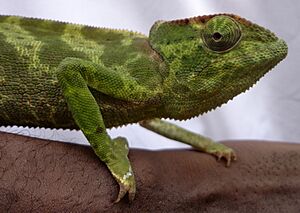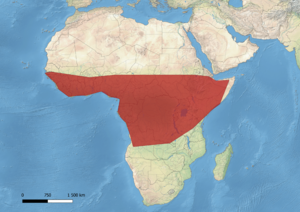Graceful chameleon facts for kids
Quick facts for kids Graceful chameleon |
|
|---|---|
 |
|
| Chamaeleo gracilis | |
| Conservation status | |
| Scientific classification | |
| Genus: |
Chamaeleo
|
| Species: |
gracilis
|
 |
|
| Synonyms | |
|
|
The graceful chameleon (Chamaeleo gracilis) is a cool type of chameleon that lives in sub-Saharan Africa. These amazing reptiles are usually about a foot (30.5 cm) long. Because there are many of them, they are sometimes caught for the pet trade.
Contents
Where Graceful Chameleons Live
Graceful chameleons can be found across a large part of Africa, south of the Sahara Desert. They live from countries like Senegal in the west, all the way to Angola in the south, and Ethiopia in the east. They mostly prefer living in forests. However, they can also live in bushy areas near farms or in open savanna grasslands.
What Graceful Chameleons Look Like
Graceful chameleons often have colors like green, yellow, or brown. They usually have a green stripe running along their side. While they are typically about a foot (30.5 cm) long, including their tail, some can grow a bit bigger, up to 15 inches (38 cm) in total length!
How Graceful Chameleons Behave
Graceful chameleons are active during the day. They hunt for their food in the morning and evening. During the hottest part of the day, they rest in the shade to stay cool. Male chameleons are very protective of their space. They often show off bright colors to warn other males to stay away. These chameleons mostly eat insects. In places where people care for them, they can live for up to 10 years.
Reproduction
Graceful chameleons breed twice each year. One breeding season happens during the dry season. The other takes place at the end of the wet season. A female chameleon can lay a lot of eggs at once. She usually lays between 20 and 50 eggs in a single clutch.
Types of Graceful Chameleons
Scientists recognize two main types, or subspecies, of the graceful chameleon.
- Chamaeleo gracilis etiennei Schmidt, 1919
- Chamaeleo gracilis gracilis Hallowell, 1844


